
Sparidae is a family of ray-finned fishes belonging to the order Spariformes, the sea breams and porgies, although they were traditionally classified in the order Perciformes. They are found in shallow temperate and tropical waters around the world and are demersal carnivores.

Threadfins are silvery grey perciform fish of the family Polynemidae. Found in tropical to subtropical waters throughout the world, the threadfin family contains eight genera and about 40 species. An unrelated species sometimes known by the name threadfin, Alectis indicus, is properly the Indian threadfish.
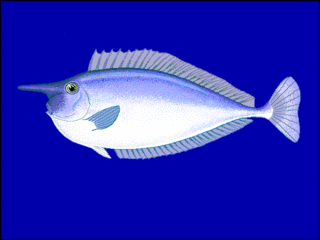
Naso is a genus of marine ray-finned fishes belonging to the family, Acanthuridae, the unicornfishes, surgeonfishes and tangs. The fishes in this genus are known commonly as unicornfishes because of the "rostral protuberance", a hornlike extension of the forehead present in some species. Unicorn fish are popular with spearfishermen and may be cooked by grilling them whole. Unicornfish primarily live around coral reefs and eat mostly algae. It is very popular in Maldives.
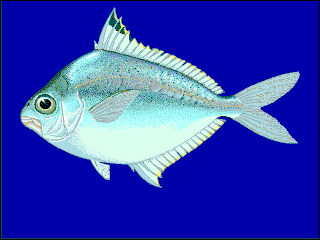
Leiognathidae, the ponyfishes, slipmouths or slimys / slimies, are a small family of fishes in the order Perciformes. They inhabit marine and brackish waters in the Indian and West Pacific Oceans. They can be used in the preparation of bagoong.

Scarus is a genus of parrotfishes. With 52 currently recognised extant species, it is by far the largest genus in this family. The vast majority are found at reefs in the Indo-Pacific, but a small number of species are found in the warmer parts of the eastern Pacific and the western Atlantic, with a single species, Scarus hoefleri in the eastern Atlantic. Most are very colourful, and have strikingly different initial and terminal phases. Adults of most species reach maximum lengths of between 30 and 50 cm (12–20 in), but the rainbow parrotfish can grow to lengths of 1.2 m (3.9 ft).

Thryssa is a genus of anchovies in the family Engraulidae. It contains the following species:

Halichoeres are a genus of wrasses found in the Atlantic, Indian and Pacific Oceans.

Polydactylus is a genus of threadfin that mainly are native to the Indian, Atlantic and Pacific Oceans, especially in coastal or brackish waters. Some may even enter rivers and a single, P. macrophthalmus, is a freshwater fish from rivers in Borneo.
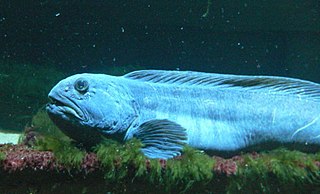
Zoarcoidei is a suborder of marine ray-finned fishes belonging to the order Scorpaeniformes. The suborder includes the wolffishes, gunnels and eelpouts. The suborder includes about 400 species. These fishes predominantly found in the boreal seas of the northern hemisphere but they have colonised the southern hemisphere.
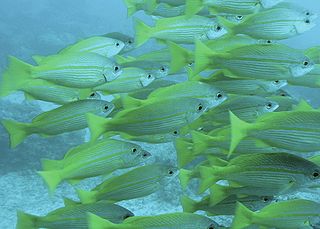
Lutjanus is a genus of marine ray-finned fish, snappers belonging to the family Lutjanidae. They are found in the Atlantic, Indian, and Pacific Oceans. They are predatory fish usually found in tropical and subtropical reefs, and mangrove forests. This genus also includes two species that only occur in fresh and brackish waters.

Decapterus is a genus of marine fishes of jack family, Carangidae, commonly known as mackerel scads, round scads, or horse mackerel. They are found throughout the world.
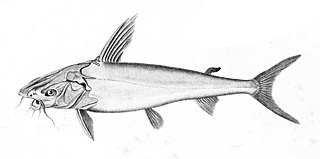
Netuma is a genus of sea catfishes found in the Indian Ocean and the western Pacific Ocean where it occurs in marine, brackish and fresh waters from the coasts of Africa to Australia to China. There are currently four recognized species in this genus.

Acropoma is a genus of fish in the family Acropomatidae, the temperate ocean-basses or lanternbellies. They are native to the Indian Ocean and western Pacific Ocean. They are characterized by a ventral luminous organ that has a luminous gland, a lens, and a reflector. The shape of the luminous organ helps distinguish the species in the genus.

Gerres is a genus of mojarras found mostly in coastal regions from the eastern Atlantic Ocean through the Indian Ocean to the western Pacific. A single species, G. simillimus, is from the East Pacific. They mainly inhabit salt and brackish waters, but will enter fresh water. At least one species, Gerres cinereus, displays an ability akin to gyroscopic stability, allowing it to remain in a remarkably static spatial position relative to the water flowing around it.

Pomadasys is a genus of grunts native to the waters of the eastern Atlantic Ocean and through the Indian Ocean to the Pacific coast of the Americas. The name of this genus is a compound of poma meaning "lid" or "covering" and dasys meaning "rough", a reference to the serrated preopercle.

Equulites is a genus of ponyfishes native to the Indian Ocean and the western Pacific Ocean. Analysis of mitochondrial DNA published in 2017 has suggested that Equulites elongates is in fact a species group made up of three species Equulites aethopos, Equulites elongates and Equulites popei.

Eubleekeria is a genus of marine ray-finned fishes, ponyfishes from the family Leiognathidae which are native to the Indian Ocean and the western Pacific Ocean.

Nuchequula is a genus of ponyfishes native to the Indian Ocean and the western Pacific Ocean.

Photopectoralis is a genus of marine ray-finned fishes, ponyfish from the family Leiognathidae. They are native to the Indian Ocean and the western Pacific Ocean.
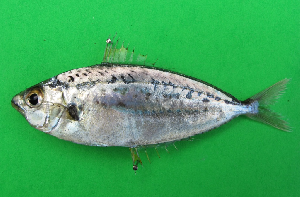
Equulites popei, Pope's ponyfish, is a species of marine ray-finned fish, a ponyfish from the family Leiognathidae. It has a wide Indo-Pacific distribution which extends from the Red Sea east to the western Pacific Ocean. It has entered the Mediterranean as a Lessepsian migrant. It was formerly considered to be synonymous with the elongate ponyfish.




















